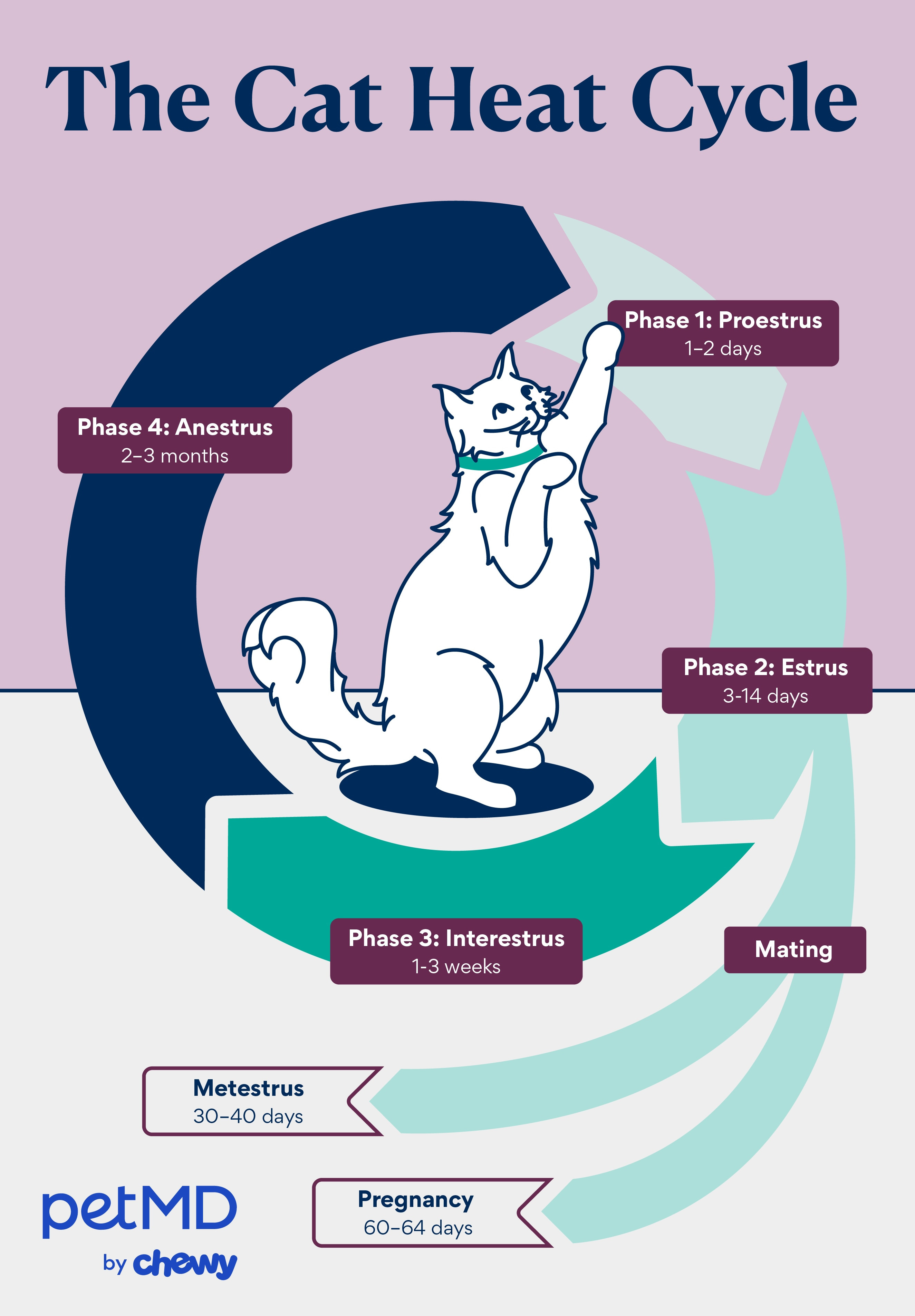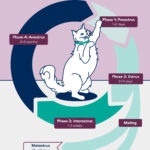For those unfamiliar with feline reproduction, the heat cycle in cats, or estrous cycle, can be a perplexing phenomenon. If you have an unspayed female cat, also known as a queen, understanding her heat cycle is crucial for responsible pet ownership. Unlike dogs or humans, a cat’s heat cycle has unique characteristics and recognizing the signs is essential, especially if you’re not planning to breed or spay your feline companion.
Understanding When Cats Start Heat Cycles
The age at which a cat first enters heat can vary, but most queens experience their first cycle between 5 and 9 months of age. However, some cats might start as early as 3-4 months, while others may not until they are around 18 months old. Several factors influence this timing, including breed, weight, and even the time of year, as seasonal changes play a significant role in a cat’s reproductive cycle.
How Long Does a Cat Stay in Heat?
 illustration depicting a cat
illustration depicting a cat
The duration of a cat’s heat cycle is not fixed and is composed of four distinct stages, each with varying lengths. Understanding these stages is key to answering the question, “How Many Days Is A Cat In Heat?”
Proestrus: The Initial Stage
Proestrus marks the beginning of the heat cycle when estrogen levels in a cat’s body start to increase. This phase is relatively short, typically lasting just one to two days. Notably, there are usually no outward signs of proestrus that are easily detectable by cat owners. During this time, male cats might show increased interest, but the female cat will not yet be receptive to mating.
Estrus: The “In Heat” Phase
Estrus is the most recognizable stage of the heat cycle, and this is what most people refer to when they ask, “how many days is a cat in heat?”. This phase generally lasts for about a week, but it can range from 3 to 14 days. During estrus, a female cat exhibits noticeable behavioral changes. She becomes receptive to mating and will actively seek out male cats.
Common signs of a cat in estrus include:
- Increased Affection: She may become excessively loving and clingy towards her owners and other pets.
- Excessive Vocalization: Queens in heat are known for their loud and persistent meowing, often described as caterwauling, to attract male cats.
- Restlessness: She may appear agitated, pacing and unable to settle down.
- Mating Posture: She might adopt a characteristic posture, known as lordosis, lowering her front body while raising her hindquarters and treading her back paws.
It’s during the estrus stage that mating will occur if the cat is allowed to interact with intact males.
Interestrus or Metestrus: Between Heat Cycles
Interestrus and metestrus are the stages that occur between estrus periods. Cats are induced ovulators, meaning they only release eggs after mating. This characteristic affects the cycle progression after estrus.
- Metestrus (Post-Ovulation if Mated): If a cat mates during estrus, ovulation is triggered, and the cycle enters metestrus. If fertilization occurs, this leads to pregnancy, lasting approximately 60-64 days. If fertilization doesn’t happen, metestrus still occurs, lasting around 30-40 days, and it represents a period of hormonal inactivity following a potential ovulation event.
- Interestrus (No Mating): If a cat in estrus does not mate and does not ovulate, she enters interestrus. This is a shorter period, lasting 1 to 3 weeks, where in-heat behaviors subside. Following interestrus, the cycle will restart with proestrus again. This means a cat can cycle back into heat relatively quickly if she doesn’t mate.
Anestrus: The Inactive Phase
Anestrus is a period of reproductive inactivity. Cat heat cycles are seasonal, heavily influenced by daylight hours. Anestrus typically occurs during the shorter daylight months of the year, usually for 2 to 3 months, often in the late fall and winter in temperate climates. During anestrus, there is minimal hormonal activity related to the reproductive cycle. This period allows the cat’s body to rest between active cycling seasons.
How Often Do Cats Go into Heat?
Understanding “how many days is a cat in heat” also involves knowing how frequently these cycles occur. Cats are “long-day breeders,” meaning their heat cycles are most active and frequent when daylight hours are longer, primarily from spring into early fall. The peak breeding season is generally from February to April. Heat cycles can continue until October or November, depending on the geographic location and daylight duration, before the cat enters anestrus. If a cat mates and becomes pregnant, the cycles will be interrupted by the pregnancy and lactation period.
Recognizing the Signs of Heat
Unlike dogs, cats do not typically bleed during their heat cycle. Therefore, recognizing behavioral changes is paramount to identifying when your cat is in heat. As mentioned earlier, a cat in heat may exhibit several behavioral changes, including:
- Extreme Affection: Demanding attention and physical contact.
- Excessive Vocalization: Loud meowing or caterwauling.
- Reduced Appetite: Some cats may eat less during heat.
- Restlessness: Pacing and general agitation.
- Urinating Outside the Litter Box: In some cases, a cat might urinate more frequently or inappropriately to mark territory, though this is less common than other signs.
It’s understandable for pet owners to be concerned, sometimes mistaking heat behaviors for signs of pain. If you observe sudden behavioral changes in your cat, it’s always wise to consult with your veterinarian to rule out any underlying health issues.
Managing a Cat in Heat
If you choose not to spay your cat, preventing unwanted pregnancies during heat cycles is essential. The primary step is to keep your cat indoors and strictly separated from intact male cats. Beyond this, there are no specific lifestyle changes required for a cat in heat.
However, it’s crucial to monitor the duration and frequency of heat cycles. Be aware of potential complications like pseudopregnancy (false pregnancy) or mucometra (accumulation of mucus in the uterus). Pyometra, a severe uterine infection, is a life-threatening condition that can occur at any age but is more common in older, unspayed cats.
Seek immediate veterinary attention if your cat displays any of these symptoms during or after her heat cycle:
- Lethargy or weakness
- Loss of appetite
- Fever
- Vaginal discharge (especially if it’s abnormal or foul-smelling)
- Swollen abdomen
Preventing Heat Cycles: Spaying
The only definitive way to prevent heat cycles and pregnancy in female cats is spaying, which involves surgically removing the uterus and ovaries. Unless you are a responsible breeder with a planned breeding program, spaying is overwhelmingly recommended for the health and well-being of your cat.
Spaying offers numerous benefits:
- Eliminates Heat Cycles: No more dealing with heat-related behaviors.
- Prevents Unwanted Pregnancies: Contributes to controlling pet overpopulation.
- Reduces Health Risks: Significantly lowers the risk of pyometra, pseudopregnancy, mammary cancer, and ovarian cancer.
There are no proven health benefits to allowing a cat to experience a heat cycle before spaying. Veterinary professionals generally recommend spaying kittens at 5-6 months of age, often before their first heat cycle, to avoid the cycle altogether and maximize health benefits.
FAQs About Cats in Heat
Do cats bleed when in heat?
No, cats should not bleed during a heat cycle. While a clear vaginal discharge can rarely occur during proestrus, any bloody discharge is abnormal and warrants an immediate veterinary visit.
Can you spay a cat while she is in heat?
Yes, spaying a cat in heat is possible. While some vets may prefer to wait until the cycle is over due to increased blood flow to the reproductive organs, it’s generally safe. Waiting for anestrus poses a greater risk of pregnancy, making spaying during heat a viable option.
Do male cats go into heat?
No, male cats do not experience heat cycles as they lack ovaries. However, intact male cats are always ready to mate and can detect females in heat from a considerable distance, often exhibiting behaviors like spraying urine and increased vocalization when they sense a nearby queen in estrus.
How many days is a cat in heat, specifically the estrus phase?
The estrus stage, which is the actual “in heat” phase with behavioral signs and receptivity to mating, typically lasts 3 to 14 days, with an average duration of around one week.
How can I confirm if my cat is in heat?
If you suspect your cat is in heat, observe her for the typical behavioral signs mentioned earlier. Consulting your veterinarian is always recommended for confirmation and to discuss spaying or other management options.
By understanding the intricacies of the feline heat cycle, especially “how many days is a cat in heat,” you can be a more informed and responsible cat owner, ensuring your queen’s health and preventing unwanted litters. Spaying remains the most effective way to manage heat cycles and contribute to your cat’s long-term well-being.


